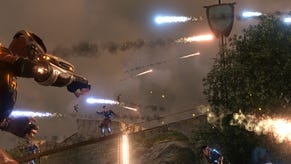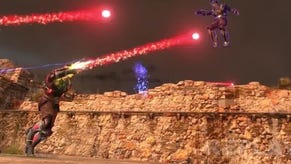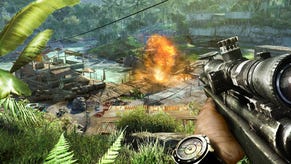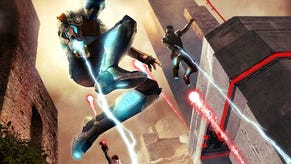ShootMania Storm Preview: Mods and Rockets
Nadeo's community shooter harks back to the 90s heyday of the FPS mod.
Your first thought on firing up ShootMania Storm is: is it 2003? With its plain looks, small maps and basic controls, this online shooter for PC seems to belong to the time French studio Nadeo last made a brand new game, the community racing sensation, TrackMania. Or even earlier than that.
Your first thought on finishing a game of ShootMania is: again, again, again! Just like TrackMania's zippy arcade stunt racing, it has a purity, playfulness, pace and instant accessibility that make it refreshing and addictive in equal measure.
Also like TrackMania, ShootMania is built for a community of tinkerers and sharers. It comes with a powerful but intuitive map editor as well as the ability to use a scripting language to write your own mods and game rules. Like last year's entirely wonderful TrackMania 2: Canyon, it lives on Nadeo's new ManiaPlanet platform, a social network and system for sharing user-generated content.
But let's get to grips with the game first. ShootMania is an abstract, vaguely science-fictional first-person shooter with a sporting feel. With its brightly coloured laser guns, green hills and red-versus-blue action, it's as cheerful and non-violent as a game about shooting other people in the face can be. Storm is the first "platform pack" or set of Nadeo-produced maps, modes and assets for the game, as Canyon was for TrackMania 2 (which will get an update called Valley next, apparently).

Battle mode is a straightforward domination mode which, at our preview event in central London, we play in teams of four. Each team needs to get to the other side of a symmetrical map to capture one or more flagpoles by standing at their bases. Once raised, flags can't be lowered. A percentage meter keeps track of the flags' position, and the first team to 100 per cent wins the round. Then you start again, and in a tennis-set-style scoring system, you need at least five wins and a lead of at least two to win the game.
So far, so unprepossessing. But with the flexible and fast editor and scripting tools that Nadeo has built for its community, it has been able to experiment and iterate on this bread-and-butter template incredibly quickly and come up with a number of simple but fun twists to the rules, as well as some devious and exquisitely balanced maps.
Using the basic rocket gun, it only takes two hits to knock out another player, but you can only take four shots before you need to wait for the gun to recharge. You can't afford to spray ammo around and really need to line up your shots. On some maps, exposed platforms give access to different weapons when you stand on them: a one-shot-kill rail gun, or a mortar-type gun that fires a stream of ammo in an arc.
You can click the right mouse button to jump, hold it to float, and the longer you're in the air, the greater the boost to your running speed after you hit the ground - but this uses up a stamina meter. If you're downed, respawning at your team's base is almost instant.
It's a game of skill and (especially) timing, but thanks to the witty and varied map design, teamwork is just as important: a good balance of attack and defence will always win the day.
There's a narrow trench with rail gun platforms on either side and exposed flags right in front of each team's spawn point. There's a map with easily defended flags separated by sunken pools, and another with flags hiding in ruins separated by a wide, open valley. On another, mortar platforms overlook flagpoles which can't be physically reached by the defending team.
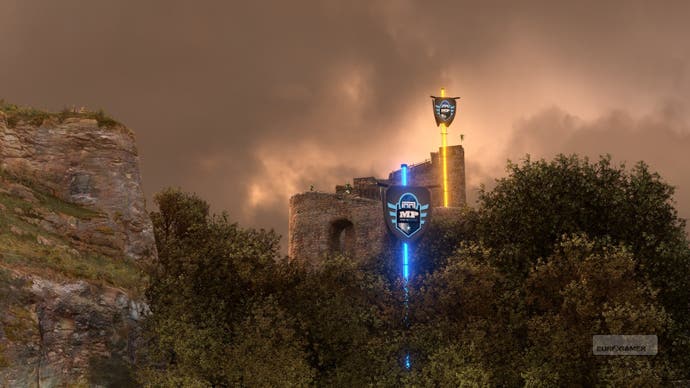
An hilarious favourite has two exposed platforms in the middle of a bottomless trench, three flags on each, and jump pads that send you soaring over from your spawn point. Each map has a subtly different tactic and play style that's easily grasped within a couple of rounds, and the combination of extreme simplicity and strong team play makes for entertainingly tight contests within minutes.
Another mode, Joust, is equally playful. In this one-on-one battle inspired by medieval jousting, two players run back and forth through a maze between two flags - because you need to touch the opposing flagpole each time you want to recharge the four shots in your gun.
Nadeo clearly isn't going to have any trouble coming up with entertaining maps and modes for its game, but the idea is that once it's in the community's hands, there'll be something new every time you load it up: new maps, new modes, new skins. This is where ManiaPlanet comes in.
ShootMania will go hand in hand with the 2.0 update to ManiaPlanet, which has a glossy main menu where downloaded platform packs, campaigns and player-created title packs for Nadeo's games appear as virtual game boxes to browse through. Facebook-style features allow you to track friends' leaderboard scores, recommendations and activity within the ManiaPlanet ecosystem. This will be the primary means of discovery for new content and challenges; there'll also be a Spotify-style system for sharing playlists.
This reflects Nadeo founder Florent Castelnerac's firm belief that ManiaPlanet should be as open a system as possible, and mimic the internet itself as much as possible. Players have to provide their own hosting for their creations, and curation of content is led by the community, not the developer. It's "more on the Windows model than Mac, we won't have a centralised marketplace," says Castelnerac (though Windows 8 might render that comparison obsolete). That also means that potentially copyright-infringing material, such as Nintendo avatars or a Lego theme for TrackMania environments is the players' problem, not Nadeo's.

That said, Nadeo does want community content to have more visibility within the games themselves, so the virtual currency of Planets - which can only be earned from participation in the games and the platform, not bought - can be spent on actual advertising slots on ManiaPlanet's various screens.
The scripting language is powerful enough to write little apps: Castelnerac shows us a player-created version of Tetris and a wilfully pointless betting game called Top O' Luck. But it's most compelling within the game, and we're shown how players can adjust game rules using the script editor while a game is actually running. The map editor is capable of building out new maps within seconds, too. The aim is for players to be able to create a new mode, a map for it, then advertise it and get people playing it within 24 hours.
ManiaPlanet is a little bewildering in its ethos and possibilities, but as with TrackMania, that's balanced out by the beautiful simplicity of the game itself. Nadeo believes that it's by giving people very deep and flexible access to straightforward, solid building blocks that you encourage a healthy and vibrant community of players and creators. Its record with TrackMania - one of the many quiet but genuinely global success stories on PC, and one of the friendliest game communities around - bears witness to that.
It's not a given that the same will happen with ShootMania, because the communities that form around racing and shooting games are very different. But by making a hugely accessible and fun game with the spirit of an old-school PC FPS mod - a Team Fortress or a Counter-Strike - Nadeo's given it the best possible chance.


